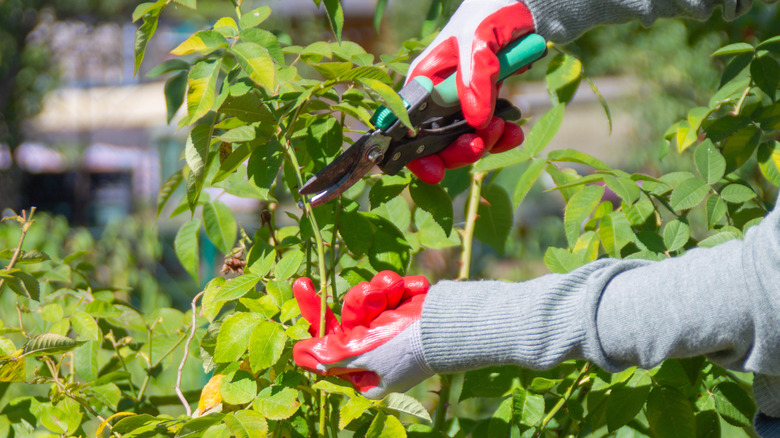Cutting Back This Type Of Plant In The Fall Could Have Unfortunate Consequences
Pruning is often a necessary fall cleanup job that gets your plants ready for spring. Removing dead or damaged wood can prevent the spread of insects or disease. Pruning can allow more air to circulate and open up the plant to sunlight, increasing the likelihood of healthy blooms the following year. Pruning can also just make a plant look neater and prevent it from spreading too far. But some plants should be left alone in the fall. Otherwise, you risk losing an entire year's blooms. To know which plants to prune in the fall and which to prune in the spring or summer, it's important to understand the difference between "old wood" and "new wood" bloomers.
Summer-blooming and repeat-blooming roses (Rosa spp.), for example, are "new wood" bloomers. Their flowers bloom on new canes that grow in the spring, so in the fall, it's a good idea to cut back any canes that show no life in them. This can protect the plant from disease and can direct the plant's energy to producing new growth. But other roses, including some (but not all) climbing roses, are "old wood" bloomers that you shouldn't be cutting back in the fall. They bloom only once a year, in late spring or early summer, before their new stems or branches have had a chance to grow. They then spend the rest of the growing season producing new wood which, by the following spring, becomes "old wood" that will produce new flowers. Cutting back trees and shrubs that produce flowers on old wood won't kill the plant, but it will mean that you see fewer flowers next spring.
How to prune old wood plants
Roses aren't the only genus that has both old-wood and new-wood species. Smooth hydrangeas (Hydrangea arborescens) and panicle hydrangeas (Hydrangea paniculata) bloom on new wood, while bigleaf hydrangeas (Hydrangea macrophylla) and oakleaf hydrangeas (Hydrangea quercifolia) are old-wood blooming hydrangea varieties that you should leave alone this fall. The same applies to spirea (Spiraea spp.) and viburnum (Viburnum spp.), where some species bloom on old wood and others on new wood.
For many other shrubs, there are two key clues to tell you which are old wood species: they already have buds on their branches in fall, and they bloom early in the spring or summer. Among the most common early bloomers are forsythia (Forsythia x intermedia), azaleas and rhododendrons (Rhododendron spp.), and lilacs (Syringa vulgaris). Other old-wood bloomers include Virginia sweetspire (Itea virginica), mock orange (Philadelphus spp.), ninebark (Physocarpus opulifolius), and quince (Chaenomeles spp.). If you see buds on the plant this fall, don't prune it. The best time of year to prune azaleas is early spring, just after they emerge from dormancy. For other early bloomers, prune them immediately after they have finished flowers in late spring or summer. This gives them ample time to produce more wood, and therefore more flowers next year.
If you want to do some pruning on old-wood bloomers this fall, focus on lilacs and forsythia. These plants produce suckers, the new shoots that emerge from the root system of the main plant. If you don't want the plant spreading, you can cut these suckers back completely in the fall rather than cutting the branches of mature shrubs. If you'd like to keep the suckers but move them elsewhere, dig them out with as much of their root system as you can keep attached, and plant them in a more suitable location.

